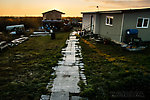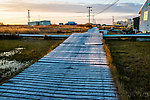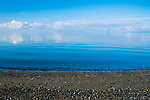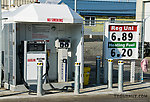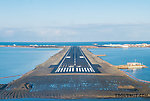Blog & Latest Updates
Fly Fishing Articles
Insects by Common Name


Latest updates, page 29
Updates from April 26, 2015
Photos by Troutnut from the Tanana River in Alaska
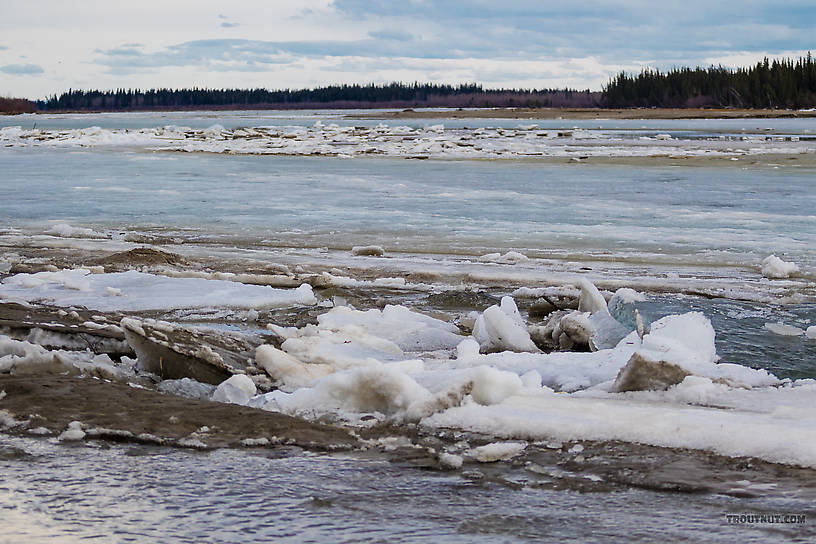
Ice breakup on the Tanana
StateAlaska
LocationTanana River
Date TakenApr 26, 2015
Date AddedSep 19, 2015
AuthorTroutnut
CameraOlympus C740UZ
Exciting adventures and misadventures in Alaska in 2014
I finally found time (with my dad's help) to post about several of this year's adventures. I was too busy early in the summer, finishing my Ph.D. and starting my new research project, to get out fishing. In August, my dad (having just retired from the Wisconsin DNR) flew up to Alaska to help with fieldwork. We didn't have enough fieldwork to justify hiring a technician this year, but it was too much to do with day-to-day volunteers, so his help for a couple weeks was extremely useful.
We blazed a trail at a small-stream study site and tested a bunch of equipment.
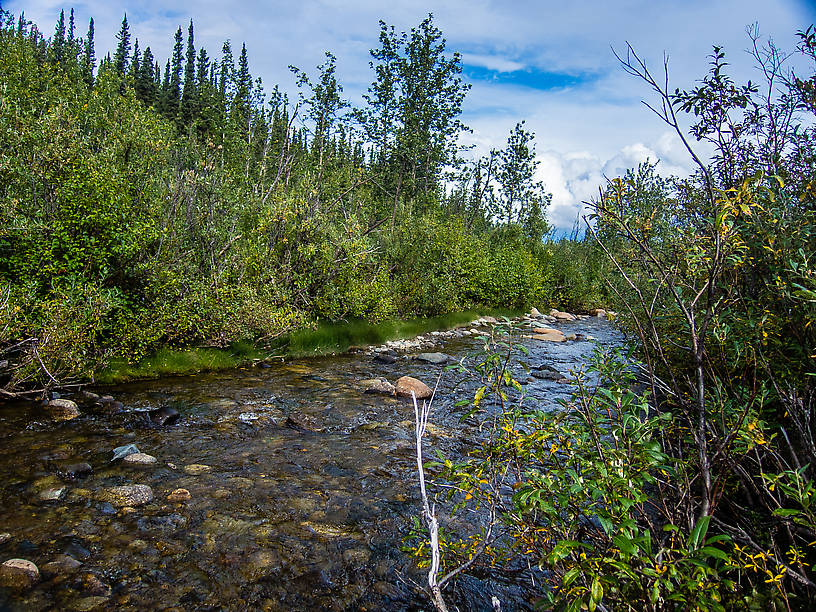

Later that same day, we met up with my wife at Denali National Park and celebrated our 4th anniversary with an exciting packraft float down Class II-III Riley Creek.
That night my wife's parents flew in, so my father-in-law came out to help us record data on Chinook salmon in the Chena River.
After that, dad and I traveled to a large spring creek study site to set up the camp our study will use for the next few years.

We accomplished a lot of productive technology testing and fly fished for big grayling to gather diet samples.
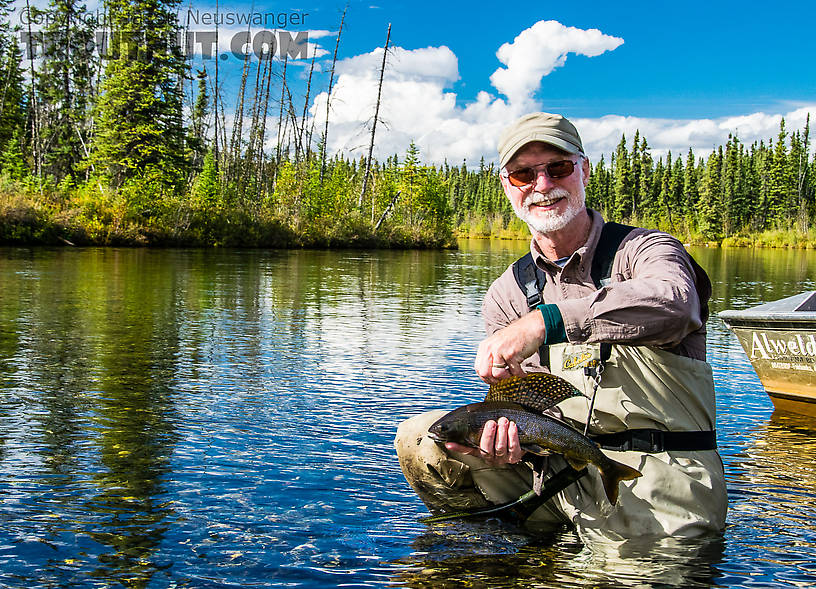
After finishing fieldwork at all of our sites, we took a few days just to hunt and fish.
Our first and most exciting trip was a caribou hunt in the Alaska Range. We hiked in about 13 miles and floated out about 15. My dad wrote up his account of the hunt, too. We saw some epic scenery, and courted disaster multiple times--the story is worth a read!


After that adventure we took a day in Fairbanks to recuperate before heading to the Kenai peninsula, where we fished the Kenai River for trout and did a saltwater charter out of Homer.
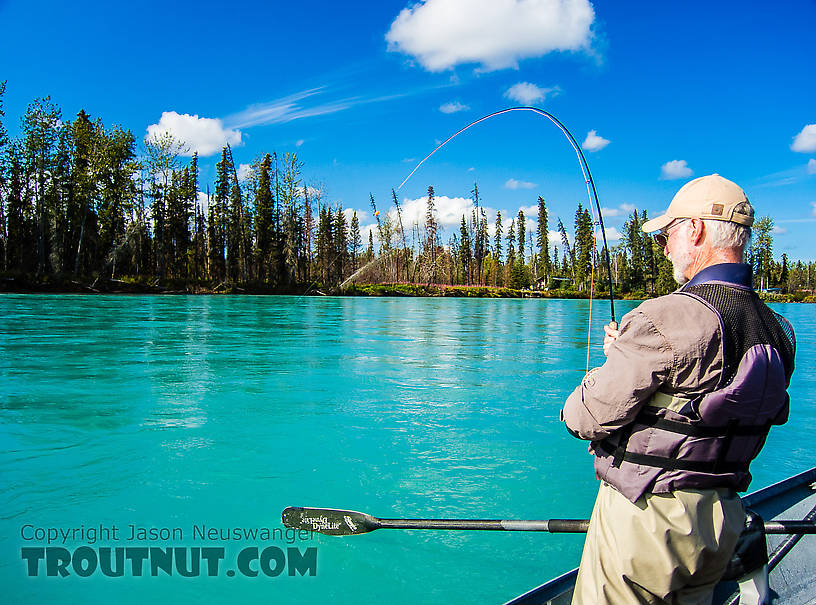
We broke up the 12-hour drive back to Fairbanks by spending a night in Talkeetna, where good weather the next morning encouraged us to take a spur-of-the-moment flightseeing tour over Denali National Park with K2 Aviation.
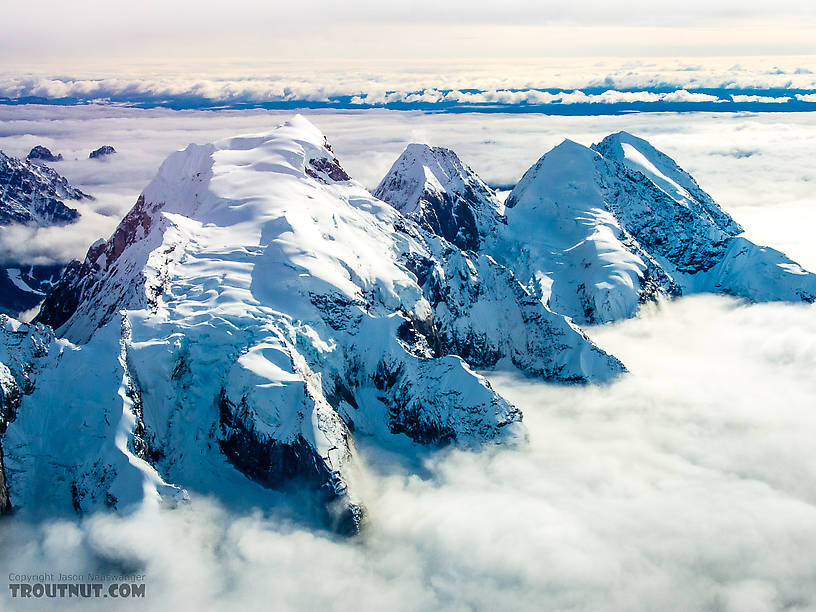
A week or so after dad left, Lena and I participated in the Denali Park road lottery, driving our vehicle in and seeing some great wildlife.
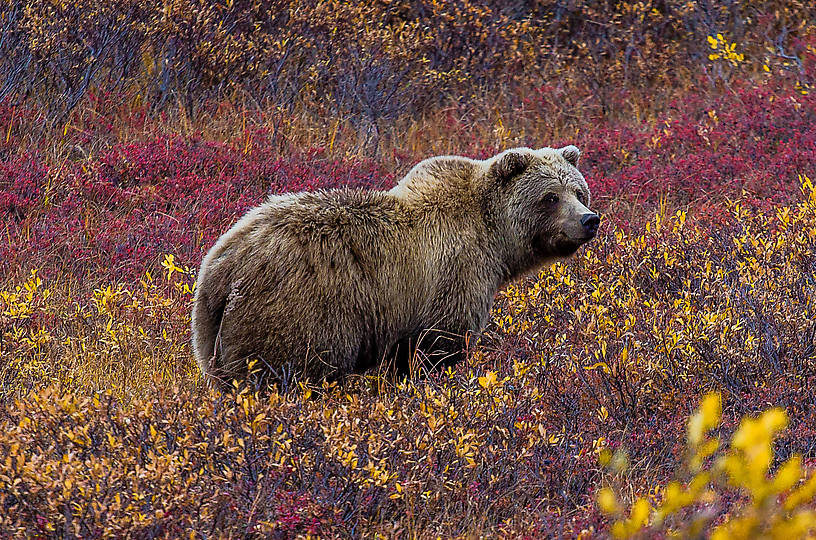
A few weeks later was my first trip to the bush to help some USFWS scientists with technology I developed during my Ph.D. See sights in Kotzebue, sights from the trip to camp through the village of Selawik, photos from the Selawik River, traveling from Selawik to Kotzebue, views of Denali Park the flight back.
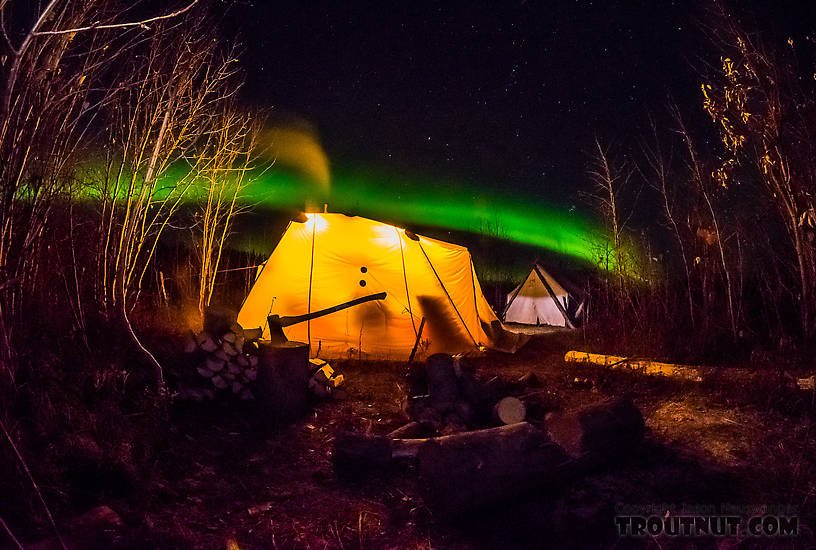
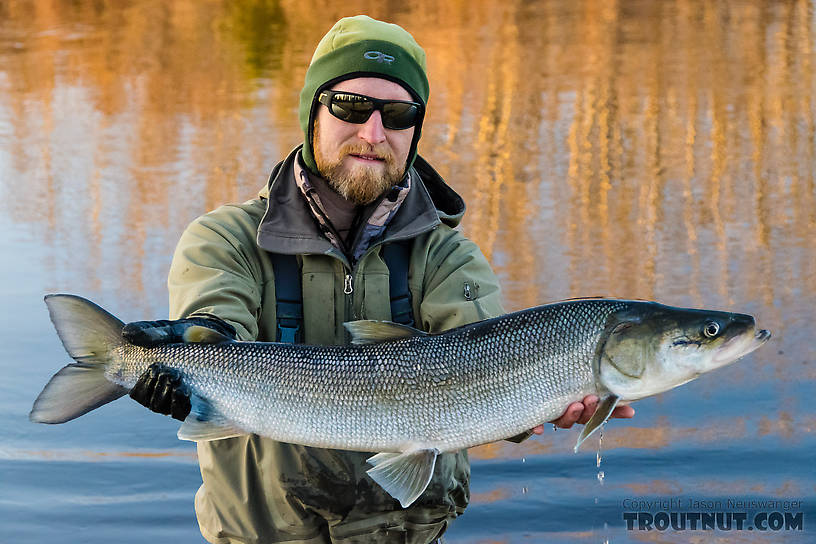
We blazed a trail at a small-stream study site and tested a bunch of equipment.


Later that same day, we met up with my wife at Denali National Park and celebrated our 4th anniversary with an exciting packraft float down Class II-III Riley Creek.
That night my wife's parents flew in, so my father-in-law came out to help us record data on Chinook salmon in the Chena River.
After that, dad and I traveled to a large spring creek study site to set up the camp our study will use for the next few years.

We accomplished a lot of productive technology testing and fly fished for big grayling to gather diet samples.

After finishing fieldwork at all of our sites, we took a few days just to hunt and fish.
Our first and most exciting trip was a caribou hunt in the Alaska Range. We hiked in about 13 miles and floated out about 15. My dad wrote up his account of the hunt, too. We saw some epic scenery, and courted disaster multiple times--the story is worth a read!


After that adventure we took a day in Fairbanks to recuperate before heading to the Kenai peninsula, where we fished the Kenai River for trout and did a saltwater charter out of Homer.

We broke up the 12-hour drive back to Fairbanks by spending a night in Talkeetna, where good weather the next morning encouraged us to take a spur-of-the-moment flightseeing tour over Denali National Park with K2 Aviation.

A week or so after dad left, Lena and I participated in the Denali Park road lottery, driving our vehicle in and seeing some great wildlife.

A few weeks later was my first trip to the bush to help some USFWS scientists with technology I developed during my Ph.D. See sights in Kotzebue, sights from the trip to camp through the village of Selawik, photos from the Selawik River, traveling from Selawik to Kotzebue, views of Denali Park the flight back.


As of this August, it's Dr. Troutnut!
I didn't post much to the site this year because I was very busy finishing my Ph.D. at the University of Alaska Fairbanks and immediately starting an exciting post-doc. I defended my dissertation in June and graduated in August, and my dissertation was finally published online recently. Anyone curious what I've been up to in Alaska can download it from ProQuest as a free PDF here:
New 3-D video methods reveal novel territorial drift-feeding behaviors that help explain environmental correlates of Chena River Chinook salmon productivity
The long-winded title results from my doing four chapters on seemingly separate topics that deeply connect to each other in detail. Overall, my dissertation is about understanding what processes and environmental variables control the success of salmonids--both individuals and entire populations. I directly studied juvenile (fingerling) Chinook salmon, but many of the results are likely to apply to trout, grayling, and any other stream fishes that engage in drift feeding (i.e. holding a stationary feeding position in the current and darting back and forth to intercept items of food).
Details of my dissertation
Chapter 1 is about technology, especially a computer program I developed (called VidSync) that makes it possible record fish with a pair of video cameras and then quickly make thousands of measurements of the fish, their environment, and their behavior. The chapter describes this program and the math behind it (which I didn't invent from scratch, although I made some important improvements). VidSync made the next two chapters possible.
Chapter 2 is about how tiny debris in the drift affect drift-feeding fish (and it was published already in Environmental Biology of Fishes). Even crystal-clear water naturally contains a large amount of fine debris, which is difficult to notice in person but jumps out on video shot at certain lighting angles, much like the dust in the air is revealed by a lone sunbeam shining into a dark room. This debris comes from many different processes, such as the gradual breakdown of wood and leaf litter by aquatic insects and bacteria, or insects shedding their exoskeletons (exuviae) between instars (Instar: Many invertebrates molt through dozens of progressively larger and better-developed stages as they grow. Each of these stages is known as an instar. Hard-bodied nymphs typically molt through more instars than soft-bodied larvae.) or during emergence. Drift-feeding fish face the very difficult task of distinguishing between debris and food of a similar size and color. It's probably especially difficult for small fish (because there's more small debris of a similar size to their prey). Most of the foraging effort of juvenile Chinook salmon was directed at debris items they either rejected without capturing or captured and spit out. This doesn't mean they're bad at feeding--it just means they had to engage their senses of taste and touch in an important way. Even large trout are sometimes found with debris in their stomachs and observed rising to inspect inedible items... including our flies. It's a bit humbling as a fly fisherman to realize that we aren't always fooling fish into thinking our fly is food--we're basically just getting them to give it the benefit of the doubt, just like they do to countless other bits of natural flotsam.
Chapter 3 is about territoriality. Previous studies of salmonid territoriality have described fish widely spaced across a pool, with territorial boundaries that can be mapped out in 2-D (i.e., mapped from a "top view" of the pool). Juvenile Chena River Chinook salmon, at first glance, behave very differently--they feed in large, 3-D schools (meaning some fish are directly above and below others) along the edges of the river. Even though this is very different from the typical, widely spaced patchwork of 2-D territories, and even though feeding territories have never been detected within schools of fish or any other animal groups, I found that some Chinook salmon were very territorial. Some were transient, "just passing through" the school in a minute or less. Many others used strategies in between the two extremes, which haven't really been studied before.
Chapter 4 is about the effect of high stream flow on the Chena River Chinook salmon population. I analyzed 20 years of salmon run data from the Alaska Department of Fish and Game, and found that the salmon do very poorly when they experienced a high-water year in the river as juveniles. This effect is probably relevant to the broader decline of Chinook salmon throughout the Yukon River drainage in recent years, although there's also probably more to the story. Hundreds of scientists are working on bits and pieces of that puzzle, because so many people depend on those fish for subsistence in rural villages. This chapter identified an important clue, but it's not the whole story.
If you're interested in a slightly more technical explanation of these chapters and how they fit together, read the abstract in the dissertation PDF.
What's next?
The same week I turned in the final draft of my dissertation, I began remotely working as an Alaska-based post-doctoral research associate at the University of Georgia. I'm working with a top expert on drift-feeding behavior, UGA Professor Gary Grossman (who writes the "Ask Dr. Trout" column in American Angler). We're starting a 3-year project studying the mechanics of drift-feeding in juvenile Chinook salmon, as well as adult grayling, and dwarf dolly varden. My hope and expectation is that this project will greatly advance our understanding of the mechanisms that control the behavior and feeding success of drift-feeding fish.
New 3-D video methods reveal novel territorial drift-feeding behaviors that help explain environmental correlates of Chena River Chinook salmon productivity
The long-winded title results from my doing four chapters on seemingly separate topics that deeply connect to each other in detail. Overall, my dissertation is about understanding what processes and environmental variables control the success of salmonids--both individuals and entire populations. I directly studied juvenile (fingerling) Chinook salmon, but many of the results are likely to apply to trout, grayling, and any other stream fishes that engage in drift feeding (i.e. holding a stationary feeding position in the current and darting back and forth to intercept items of food).
Details of my dissertation
Chapter 1 is about technology, especially a computer program I developed (called VidSync) that makes it possible record fish with a pair of video cameras and then quickly make thousands of measurements of the fish, their environment, and their behavior. The chapter describes this program and the math behind it (which I didn't invent from scratch, although I made some important improvements). VidSync made the next two chapters possible.
Chapter 2 is about how tiny debris in the drift affect drift-feeding fish (and it was published already in Environmental Biology of Fishes). Even crystal-clear water naturally contains a large amount of fine debris, which is difficult to notice in person but jumps out on video shot at certain lighting angles, much like the dust in the air is revealed by a lone sunbeam shining into a dark room. This debris comes from many different processes, such as the gradual breakdown of wood and leaf litter by aquatic insects and bacteria, or insects shedding their exoskeletons (exuviae) between instars (Instar: Many invertebrates molt through dozens of progressively larger and better-developed stages as they grow. Each of these stages is known as an instar. Hard-bodied nymphs typically molt through more instars than soft-bodied larvae.) or during emergence. Drift-feeding fish face the very difficult task of distinguishing between debris and food of a similar size and color. It's probably especially difficult for small fish (because there's more small debris of a similar size to their prey). Most of the foraging effort of juvenile Chinook salmon was directed at debris items they either rejected without capturing or captured and spit out. This doesn't mean they're bad at feeding--it just means they had to engage their senses of taste and touch in an important way. Even large trout are sometimes found with debris in their stomachs and observed rising to inspect inedible items... including our flies. It's a bit humbling as a fly fisherman to realize that we aren't always fooling fish into thinking our fly is food--we're basically just getting them to give it the benefit of the doubt, just like they do to countless other bits of natural flotsam.
Chapter 3 is about territoriality. Previous studies of salmonid territoriality have described fish widely spaced across a pool, with territorial boundaries that can be mapped out in 2-D (i.e., mapped from a "top view" of the pool). Juvenile Chena River Chinook salmon, at first glance, behave very differently--they feed in large, 3-D schools (meaning some fish are directly above and below others) along the edges of the river. Even though this is very different from the typical, widely spaced patchwork of 2-D territories, and even though feeding territories have never been detected within schools of fish or any other animal groups, I found that some Chinook salmon were very territorial. Some were transient, "just passing through" the school in a minute or less. Many others used strategies in between the two extremes, which haven't really been studied before.
Chapter 4 is about the effect of high stream flow on the Chena River Chinook salmon population. I analyzed 20 years of salmon run data from the Alaska Department of Fish and Game, and found that the salmon do very poorly when they experienced a high-water year in the river as juveniles. This effect is probably relevant to the broader decline of Chinook salmon throughout the Yukon River drainage in recent years, although there's also probably more to the story. Hundreds of scientists are working on bits and pieces of that puzzle, because so many people depend on those fish for subsistence in rural villages. This chapter identified an important clue, but it's not the whole story.
If you're interested in a slightly more technical explanation of these chapters and how they fit together, read the abstract in the dissertation PDF.
What's next?
The same week I turned in the final draft of my dissertation, I began remotely working as an Alaska-based post-doctoral research associate at the University of Georgia. I'm working with a top expert on drift-feeding behavior, UGA Professor Gary Grossman (who writes the "Ask Dr. Trout" column in American Angler). We're starting a 3-year project studying the mechanics of drift-feeding in juvenile Chinook salmon, as well as adult grayling, and dwarf dolly varden. My hope and expectation is that this project will greatly advance our understanding of the mechanisms that control the behavior and feeding success of drift-feeding fish.
The Alaska Range seen from the southwest
I had some spectacular views on my flight from Kotzebue back to Anchorage.
Photos by Troutnut from Denali National Park in Alaska
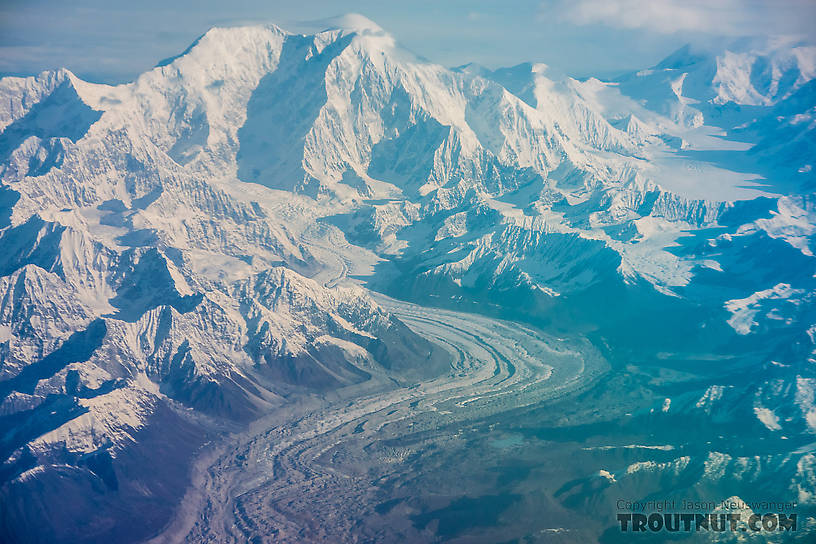
Mt Foraker and the Lacuna Glacier seen from a flight from Kotzebue to Anchorage
StateAlaska
LocationDenali National Park
Date TakenSep 24, 2014
Date AddedDec 23, 2014
AuthorTroutnut
CameraNIKON D5300
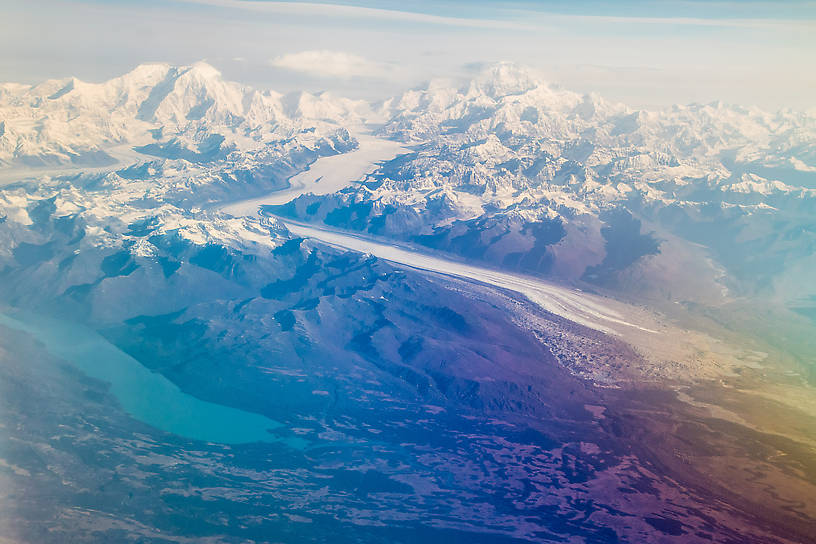
Mt Foraker (left), Denali (right), Kahiltna Glacier, and Chelatna Lake, the outlet of which (Lake Creek) is known for great fishing and difficult floating. Viewed from a flight from Kotzebue to Anchorage.
StateAlaska
LocationDenali National Park
Date TakenSep 24, 2014
Date AddedDec 23, 2014
AuthorTroutnut
CameraNIKON D5300
Traveling from Selawik to Kotzebue
Photos by Troutnut from the Selawik River and Miscellaneous Alaska in Alaska
Top 10 Fly Hatches
Top Gift Shop Designs
Eat mayflies.
Top Insect Specimens
Miscellaneous Sites
Troutnut.com is copyright © 2004-2024 Jason
Neuswanger (email Jason). See my FAQ for information about use of my images.
 privacy policy
privacy policy

